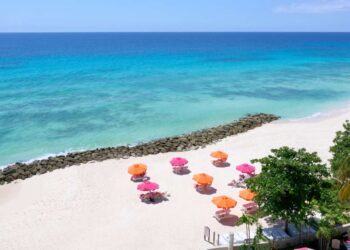Scenic national parks exist all over the world, but the United States invented the concept in 1872 when then-president Ulysses S. Grant established Yellowstone with a decree that proclaimed it “a public park or pleasuring-ground for the benefit and enjoyment of the people.”
The idea caught on fast. Today, these protected landscapes span six continents, 1,000 locations, and 100 nations. Their purpose is to conserve and protect natural beauty and wildlife while offering a respite for humans eager to soak up stunning natural wonders.
From the fiery red sandstone cliffs towering in Zion National Park to the deep Grand Canyon to wildlife paradises like Kruger and Galapagos, the planet’s best national parks are so diverse that it’s hard to know where to explore first. To help narrow down your travel plans, we’ve compiled a list of national parks around the world featuring diverse wildlife, unique geology and ecology, and abundant outdoor recreation opportunities.
Kakadu National Park, Australia
With over 700 national parks to its name, Australia boasts more national parks than any other country in the world. To put that into perspective, the United States has just over 400 and China has about 200. It’s hard to pick the best national park in the country, but Kakadu is certainly high on the list. This 5-million-acre biodiverse reprieve, located in the verdant heart of the country, is filled with expansive tropical landscapes, towering waterfalls, and countless plant species and wildlife.
How to Get There: Fly into Darwin International Airport and take a scenic road trip approximately 3 hours southeast to reach this park’s majestic landscapes.
Torres del Paine, Chile
From glaciers to lakes to mountain peaks, the dazzling landscapes of Torres del Paine make it one of the world’s most spectacular national parks. Challenge yourself with a hike to the base of the Torres del Paine (Towers of Paine), a set of granite peaks that appear to rise from the ground into the sky. See ice formations up close and personal with a boat tour to Grey Glacier or a hike along crystal blue, ice-filled Lago Grey. Find the best panoramic views of the park’s turquoise lakes and mountains from the Mirador Las Torres viewpoint.
How to Get There: Punta Arenas Airport is the closest airport. From here, you’ll take a four to five hour road trip northward and can catch views of the Patagonian landscapes along the way.
Killarney National Park, Ireland
Explore this island nation’s rugged mountain landscapes in Killarney National Park. Start with a hike to see the magnificent McGillycuddy’s Reeks, Ireland’s highest mountain range at over 3,400 feet. Then ride a horse-drawn jaunting car to admire the evergreen trees and shrubs or stroll through the exquisite gardens of Muckross House, a preserved 19th-century mansion. From the house, walk to the ruins of a preserved Franciscan friary called Muckross Abbey. Or skip the woods and get on the water with a boat tour from Ross Castle to Innisfallen Island to explore ruins on a now-deserted island.
How to Get There: You can fly into Kerry airport, which is only 15 minutes from the park. Alternatively, fly into Dublin, rent a car, and make the three to four hour southwestern trek across the country.
Plitvice National Park, Croatia
Croatia’s oldest and largest national park is also the country’s most beloved, and while Plitvice Lakes National Park primarily protects grasslands and forest vegetation, it’s best known for its cascading lakes and waterfalls. This UNESCO World Heritage Site is made up of 16 named lakes that create over 90 waterfalls. Wander through the woods on seven trails featuring boardwalks suspended over these dazzling turquoise waters for fairyland nature views.
How to Get There: Zagreb airport is a two hour drive from Plitvice National Park. You can book a tour that departs from the city, or rent a car and drive.
Fiordland National Park, New Zealand
Southwest New Zealand is home to Fiordland National Park, a natural oasis filled with fiords, rainforests, mountain peaks, and endangered species. Explore legendary Milford Sound, a glacier-carved sea inlet surrounded by waterfalls, mountains, and marine life, by kayak or boat tour. Then visit triple-tiered Sutherland Falls, one of New Zealand’s tallest waterfalls. For those looking to lace up and put in mile after mile, head to The Milford Track, one of New Zealand’s most famous hiking trails. It takes four days to complete and showcases the region’s waterfalls, rainforests, and mountain passes.
How to Get There: The nearest major airport is Queenstown Airport, which is a three hour drive from the dramatic fjords.
Yosemite National Park, California, United States
Yosemite National Park’s rocky wonderscape was the world’s first land protected for the public good in 1864. The park’s known for its towering granite monoliths, waterfalls, lush valley, abundant wildlife, and giant ancient sequoia trees. Summer is its busiest season, but the park is a spectacular destination year-round. Yosemite’s diverse landscapes also house and protect over 400 animal species, including black bears, birds, reptiles, and amphibians.
How to Get There: Yosemite is a one-and-a-half hour drive from Fresno Yosemite International Airport, or if you’re up for a three to four hour drive you can fly into San Francisco.
Yellowstone National Park, Wyoming, United States
Claiming the title of the world’s first national park, Yellowstone sits on top of a dormant volcano and was preserved to protect its hydro and geothermal features. The park is home to 50 percent of the planet’s hydrothermal features, including hot springs and the iconic Old Faithful geyser. Spanning 3,500 miles, Yellowstone is one of America’s largest and best national parks and is home to wildlife like grizzlies, bison, wolves, and deer. Don’t miss the colorful Grand Prismatic Spring, one of the world’s largest hot springs, and the Grand Canyon of the Yellowstone River.
How to Get There: To access the eastern entry, fly into Yellowstone Regional Airport in Cody, Wyoming. For the west entry, opt for Bozeman Yellowstone International Airport in Gallatin County, Montana. Both are about an hour and a half away.
Galapagos National Park, Ecuador
Established in 1959, Galapagos National Park is the oldest National Park in Ecuador. Today about 97 percent of it is part of the National Park System and remains uninhabited. Visitors primarily visit to see the park’s many endemic species, including giant tortoises, marine iguanas, Darwin’s finches, and blue-footed boobies. Over 9,000 species have been discovered, but more are found here each year. Visitors can take cruises or guided land-based day trips to explore, kayak, and hike around the islands.
How to Get There: Typically, visitors first fly into Ecuador and then travel by air to Galapagos from either Guayaquil or Quito. The Galapagos has two main airports: one on Baltra Island and another on San Cristóbal. For a more adventurous route, you can travel by sea, which takes about three days.
Banff National Park, Canada
Experience the majestic beauty of the Canadian Rockies in Banff National Park, Canada’s oldest and most visited national park. Glacial-blue lakes, snow-capped peaks, and endless forests make up the dazzling landscapes, with the most iconic sights being teal-colored Moraine Lake and Lake Louise. Canoe the icy blue waters, or simply bask in the view with a walk around the lakeshore. Skiing and snowboarding are popular winter pursuits at Banff National Park, with hiking and camping taking center stage in summer. For spectacular vistas, ride the Banff Gondola up Sulphur Mountain and visit the restaurant and boardwalk.
How to Get There: After landing in Calgary International Airport, you’ll take a one to two-hour drive directly west to reach the park.
Bryce Canyon National Park, Utah, United States
Utah’s Bryce Canyon National Park dazzles with its unique red rock hoodoos. These thin orange, red, and white spires appear to rise from the canyon floor, but they’re actually the product of millions of years of erosion. The best way to see these wild rock formations is on a sunrise or sunset hike along the Navajo or Fairyland Loop Trails. As beautiful as Bryce is in the summer, it’s also one of the best U.S. National Parks to visit in winter. Visitors can snowshoe and hike among snow-dusted hoodoos — a unique sight unlike anywhere else in the world. No matter when you visit, Bryce is accessible to any fitness level. Simply stand on the canyon’s edge and marvel at the wonders below.
How to Get There: From St. George Regional Airport, take a scenic two hour drive to reach the park’s iconic crimson-hued hoodoos. You can charter flights from larger airports, including Las Vegas, Salt Lake City, Phoenix, and Denver, or plan a lengthy road trip from any of the above.
Grand Canyon National Park, Arizona, United States
Known as one of the Earth’s most iconic natural landmarks, the Grand Canyon’s claim to fame is its deep, colorful cliffs carved by the Colorado River over millions of years. The canyon itself is over a mile deep and stretches 277 miles through Arizona. Visitors come to gaze into its open expanse below or to venture down winding trails for hiking, river rafting, horseback riding, and camping. Various viewpoints showcase the area’s geology and history, but none is more stunning than the Grand Canyon Skywalk, a horseshoe-shaped glass walkway bridge at Arizona’s Eagle Point.
How to Get There: Fly into Phoenix Sky Harbor, then make the three to four hour drive to the Grand Canyon. Consider swinging through Sedona and Flagstaff, which are on the way.
Lake District National Park, England
Northwest England’s Lake District National Park features 16 lakes spread through spectacular mountains and forests. While the lakes are a popular destination for boating and fishing, many visitors come with an entirely different plan: summiting Scafell Pike, England’s highest mountain.
History buffs may want to skip the long hike and venture instead to Castlerigg Stone Circle, a prehistoric monument that dates back 4,000 years and is regarded as one of Britain’s best-preserved stone circles. To learn about the region’s slate mining history, visit Honister Slate Mine to see this old business-turned-tourist attraction, try mine climbing, or traverse a thrilling via ferrata.
How to Get There: Fly into either Manchester Airport or Newcastle International Airport. The former is roughly an hour away while the other is a 1.5-hour drive.
Zion National Park, Utah, United States
Travel to southern Utah to experience the beauty of Zion National Park’s red rock cliffs, canyons, and rock formations. From wading through the Virgin River in The Narrows to using chains bolted into the rock to free climb up technical switchbacks at Angels Landing, adventures here are thrilling, scenic, and undeniably unique. Take in the full beauty of this place on a drive along Zion Canyon Scenic Drive, or catch a shuttle from the visitor’s center to ride through this desert panorama and access popular trails.
How to Get There: From St. George Regional Airport, you’ll take a 45-minute picturesque drive to reach the park’s towering sandstone cliffs. Alternatively, fly into Las Vegas and drive two hours east.
Zhangjiajie National Forest Park, China
Channel Avatar vibes in China’s Zhangjiajie National Forest Park, where towering sandstone peaks and pillars served as the inspiration for Avatar’s floating mountains. Often blanketed in fog, the Hallelujah Mountains can be seen via cable car or a hike up the mountain. The park’s also home to a man-made wonder, The Zhangjiajie Glass Bridge, a 400-meter span that makes it the longest and tallest pedestrian bridge in the world.
How to Get There: Zhangjiajie Hehua Airport is less than an hour from the park.
Mount Kilimanjaro National Park, Tanzania
Hikers and mountaineers venture to Mount Kilimanjaro National Park in Tanzania for summiting, sightseeing, and wildlife viewing. This UNESCO World Heritage site is known for its namesake peak: Mount Kilimanjaro. The rewarding climb takes visitors up the highest peak in Africa at 19,341 feet. From Uruhu Peak, the highest point on Mount Kilimanjaro, enjoy vast panoramas of the surrounding African landscape. Beyond the peaks, the region is home to monkeys, baboons, leopards, elephants, and more.
How to Get There: The nearest airport is Kilimanjaro International Airport, which is about an hour and a half away. Along the way, you’ll traverse some of Africa’s diverse ecosystems and some scenic vistas.
Kruger National Park, South Africa
People come to Kruger National Park not for the scenery but for the wildlife. This park is home to lions, elephants, leopards, buffalo, giraffes, zebras, and rhinoceros, and you can experience them up close on a guided game drive. Available morning to night, they’re the safest way to see the animals. A scenic drive also showcases the rivers and landscapes, or you can venture on foot with a guided bush walk. Led by an armed safari ranger, the walks take three to four hours and can feature adrenaline-pumping experiences like elephant and buffalo sightings.
How to Get There: To access the park’s vast savannahs, fly into Kruger Mpumalanga International Airport and drive about an hour northeast.
Victoria Falls National Park, Zambia
See Victoria Falls, one of the Seven Wonders of the World, in this expansive national park in Zambia. The waterfall is a mile wide and over 300 feet tall, making it the planet’s largest (and easily the most impressive). Jump in the water at Devil’s Pool, a thrilling swimming experience on the edge of Victoria Falls. Adventures abound here, and visitors can get their thrill zip lining, whitewater rafting, and bungee jumping, or keep it simple by hiking beautiful trails spread through natural landscapes.
How to Get There: The Victoria Falls International Airport is a quick 20-minute drive from the idyllic falls. You can also fly into Harry Mwanga Nkumbula International Airport, which is about the same distance.
Hawai’i Volcanoes, Hawaii, United States
Head to Hawaii’s Big Island to see two of the world’s most active volcanoes in Hawai’i Volcanoes National Park. See Kilauea’s lava flows, craters, and steam vents with a drive along Chain of the Craters Road, then learn about the area’s geology and history at Jaggar Museum — located on the rim of Kilauea Crater. Explore eruptions past with a hike through Thurston Lava Tube, an underground cave formed by flowing lava.
How to Get There: Fly into Hilo International Airport from Honolulu International Airport and take a beautiful 45-minute drive.
Fuji Hakone Izu National Park, Japan
Explore Japan’s highest mountain and soak in popular natural hot springs in Fuji-Hakone-Izu National Park. The bucket list goal here is taking a guided hike up Mount Fuji, but if you’re not up for the climb, chill and take in the mountain view at Lake Ashi. After a day spent hiking the trails, head for the nearby town of Hakone Hot Springs to soak your cares and muscle aches away.
How to Get There: Fuji Hakone Izu National Park is a two-hour drive from Tokyo Haneda Airport. Between the two, you’ll catch views of Mount Fuji, lush foliage, and lakes. Tokyo Narita is just under three hours away.







